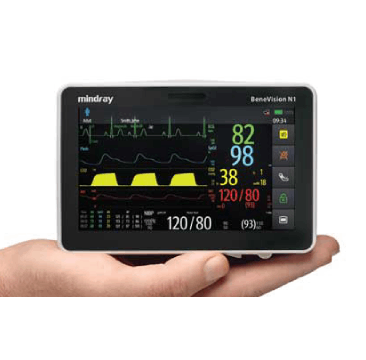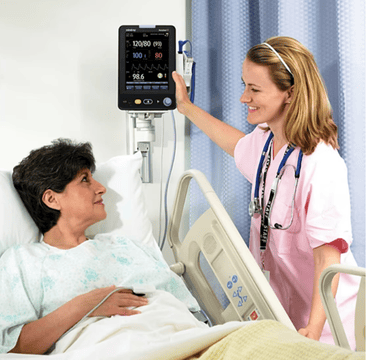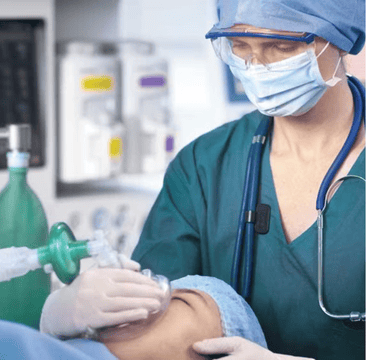Within hospitals, patients are often transported between different departments, such as from the emergency department (ED) to the intensive care unit (ICU) or from the ICU to radiology. Clinicians grant patient transfers when necessary procedures or diagnostic tests cannot be brought to the bedside.
Moving patients between departments can be high-risk, particularly for critically ill patients. Studies have shown that adverse events resulting from intrahospital transport occur in 6% up to 70% of cases. A 2025 study reports that adverse events during transport occur at a disproportionately high rate for pediatric patients who are critically ill or anesthetized. Five percent of pediatric anesthesia-related adverse events stem from transport or patient repositioning.
- Grab-and-go functionality: A transport monitor should be compact, lightweight, and offer multiple mounting solutions, including a transport module rack with a bed rail hook. This enables clinicians to seamlessly detach the transport monitor from the bedside unit without connecting and reconnecting multiple cables
- Defibrillator synchronization: Critically ill patients must be accompanied by cardiac monitoring and defibrillators when being transported between departments to enable prompt intervention if a life-threatening arrhythmia occurs. Choosing a transport monitor that facilitates defibrillator synchronization allows clinicians to perform synchronized cardioversion safely and effectively as patients are being transported
- Long battery run time: Transport monitors must run for the entire transport duration to ensure data continuity. Its battery life should account for unexpected delays, like the need to perform an intervention during transport. Generally, transport monitors should feature battery run times of at least a couple of hours, though longer is better. The BeneVision N1 Monitor/Module offers a battery run time of eight hours
- Robust connectivity: Remote patient monitoring during transport allows clinical teams to view patient data from a centralized station in real time. These devices connect wirelessly to electronic medical records (EMRs), transmitting data without the need for manual input
The BeneVision N1 Monitor/Module — One Monitor, Multiple Solutions
Mindray North America's BeneVision N1 Transport Monitor provides patient monitoring continuity during intrahospital transport, allowing clinicians to overcome their most complex patient transport challenges. With the N1 Monitor's integrated wireless capabilities and long battery life, patients will remain well-connected throughout their stay.
Featuring a straightforward design, the N1 Monitor helps simplify the logistics of patient transfer. Clinicians can slide the N1 Monitor from the patient’s bedside monitor and begin the process of transporting a patient. The N1 Monitor instantly converts to a wireless transport monitor, maintaining data continuity with the BeneVision Distributed Monitoring System (DMS)/EMR.
When connected to the Mindray touchscreen display, the N1 Monitor provides clinicians with full bedside monitoring capabilities plus practical features that support multiple screen layouts and configurable quick keys to ease the patient transfer.
Mindray’s innovative transport monitoring solutions provide versatility to meet the many needs of your hospital environment.
Why Trust Mindray?
Mindray focuses on developing patient monitoring solutions that solve complex challenges in demanding healthcare settings. Our solutions, such as the N1 Transport Monitor, were developed to streamline clinical workflows and support enhanced patient care at various acuity levels.
We understand that every minute matters in healthcare. We also know that clinicians need more than just a medical equipment supplier to find the solutions they need. That's why we emphasize a partnership approach and work closely with clinical teams to ensure we provide medical technology that complements unique workflows and promotes the delivery of high-quality patient care.
Advanced Patient Monitoring With Mindray
Many patients require more than basic vital signs monitoring during transport to receive the level of care they need. With a robust and intuitive transport monitoring solution, clinicians can ensure high acuity patients are monitored continuously without complicating the team's workflow.
If you are looking to purchase a leading-edge transport monitor, consider Mindray. Our N1 Transport Monitor provides continuity of patient monitoring data as they're transferred within your facility, from ED to ICU or the operating room (OR) to PACU. With integrated wireless connectivity and long battery life, your patients and clinicians stay well-connected. Contact us to learn more about the N1 Monitor or our other patient monitoring solutions.






